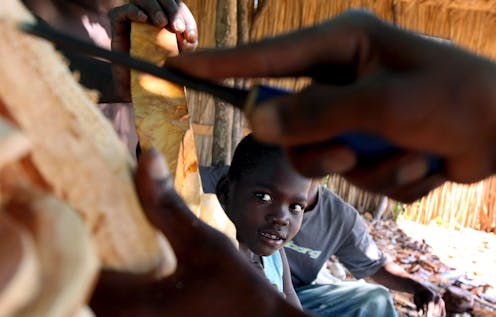Land, culture, livelihood: what Indigenous people stand to lose from climate 'solutions'
- Written by Robert Hales, Director Centre for Sustainable Enterprise, Griffith University

In the first major deal of the Glasgow climate summit, more than 100 nations have pledged to end, and reverse, deforestation by 2030. As the declaration states, forests store vast amounts of carbon dioxide and are essential to stop global warming beyond 1.5℃ this century.
This new pledge is an example of so-called “nature-based solutions” – using ecosystem restoration and protection, better forest management and forest plantations to tackle climate change. Research suggests, if done appropriately, they could provide 30–40% of the CO₂ reductions required by 2030.
But these approaches should not take away from the need to stop burning fossil fuels. There’s also a glaring omission in the new declaration: no mention of the need for Indigenous people to give our/their prior informed consent, or be the decision makers on our/their own land.
This is significant, because some nature-based solutions can negatively affect Indigenous people around the world. For this reason, more than 250 organisations, networks and movements have signed a new statement against nature-based solutions, calling them nature-based “dispossessions”, and a scam.
Indigenous people should have a seat at the table in Glasgow, and a voice in decisions about our/their lands. The best pathway forward for Indigenous people is to manage carbon projects themselves. This is true self determination.
Disrupting livelihood and culture
Indigenous people manage or have tenure rights over at least 38 million square kilometres in 87 countries on all inhabited continents. This represents over a quarter of the world’s land surface, intersecting about 40% of all land-based protected areas and ecologically intact landscapes.
And yet, disadvantage is still widespread. International carbon policies such as nature-based climate schemes continue to contribute to a variety of poverties.
Examples abound. Take, for instance, the REDD+ program which operates under the auspices of the United Nations. It aims to reduce emissions from deforestation and forest degradation, such as through sustainable management of forests to increase carbon stocks.
A review in 2018 revealed how REDD+ projects disrupted local peoples’ livelihoods and culture in various ways. The more serious impacts included:
creating food insecurity by reducing the availability of agricultural land
loss of land through shifts in land tenure and forest management to outside corporations
unfair consent processes which do not include all people affected by projects
the clearing of forest to make way for monoculture plantations with higher carbon storage
limited formal frameworks to maintain local livelihoods and biodiversity.
Indigenous people must benefit
Less than 1% of climate finance from developed nations supports Indigenous and local community tenure security and forest management.
But research suggests securing the rights of Indigenous People to our/their homelands would help conserve more carbon in the territories under our/their control. Land managed by Indigenous people tends to have lower rates of deforestation and store more carbon than lands managed or owned by non-Indigenous People.
Under a best-case scenario, First Nations ownership of land would be recognised under law. Projects should be designed to acknowledge Indigenous participation and priorities. And the practices should draw on western science and Indigenous science and knowledge.
And when nature-based solutions are proposed, land tenure issues need to be resolved, and Indigenous rights need to be respected. These are the preconditions that lead to benefits for both Indigenous people and the climate.
The Aboriginal Carbon Foundation in Australia is an excellent example of such a scheme. It involves savanna fire management projects in northern Australia to reduce the frequency and extent of late dry season fires. This results in fewer greenhouse-gas emissions and more carbon stored in dead organic matter.
Core benefits are developed by Traditional Owners and later verified. They include:
improved social ties as community members work together on projects using a peer-to-peer framework
elders sharing traditional ecological knowledge with young people
Indigenous-led land management that protects the environment, rock art and sacred sites
meaningful employment that aligns with the interests and values of Traditional Owners
increased pride and self-esteem of Indigenous people.
The real culprit
Indigenous people are not just vulnerable to the effects of climate change solutions, they can also be disproportionately affected by climate change itself. Traditional Owners often live on lands directly affected by climate change and can also lack the social and economic infrastructure to ensure resilience to respond to these changes.
This underscores why Indigenous people should be at the centre of decision-making about climate change and solutions to address it.
Recognition of this need is slowly growing. But more needs to be done – including enshrining the rights of Indigenous people in Paris Agreement rules governing carbon trading.
Read more: Why UNESCO's 'nature based solutions' to water problems won't work in Africa
What’s more, the high cost of global travel and accommodation and restrictions during the COVID-19 pandemic hinders the attendance of First Nations leaders at international talks.
A Local Communities and Indigenous Peoples Platform was formalised at COP21 in Paris. But it remains to be seen whether this will influence negotiations at COP26.
Finally, while nature-based solutions have the potential to be an important response to reducing human-caused emissions, they are fraught with danger. The real culpability for climate change lies with nations and regions that burn large amounts of fossil fuels.
First Nations people should not be forced to carry the burden of climate action. Instead, world leaders must prioritise reducing CO₂ emissions at their source.
At the same time, they must recognise the rights and interests of Indigenous people and guarantee climate solutions are determined by Traditional Owners on our/their land.
Authors: Robert Hales, Director Centre for Sustainable Enterprise, Griffith University





